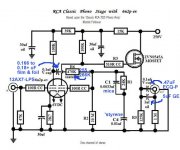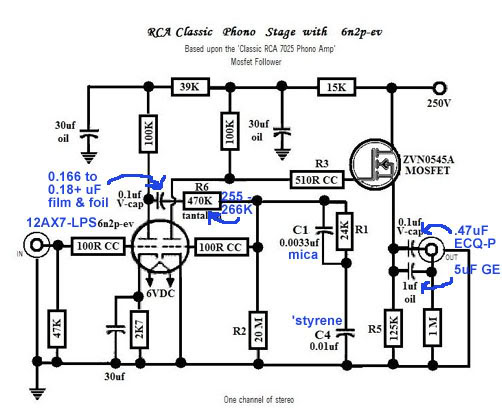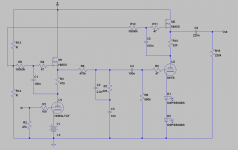I decided I want to try my hand at an RIAA phono stage. I'm sure I have the iron and have these tubes. I'm open for suggestions if there are better tubes to use. I want to keep the first one as simple as possible. I would like to see schematics of what you have built.
Thanks
Thanks
I suggest you to read the article "on RIAA equalization networks" from Stanley P. Lipshitz. It has lots of "juice". I´m doing something like this, but in OPA state, and it explain well pros and cons, and how to calculate time constants of yourself, and make your own circuit.
Good Luck
Good Luck
The tubes are a minor part of the cost, but I do understand the attraction to using what you have on hand.
There is a neat 6SL7/6SN7/7F8 project in one of the old Sound Practices magazine, the 7F8 is a loctal, which keeps them all cheap and NOS. PM me for more info.
"Simple" and "tube phono preamp" are usually two things that don't go together, but there are some out there.
The other plan of attack is to use a circuit board, something like an Aikido from GlassWare (no Octal, however) or maybe SY's "his master's noise" http://www.diyaudio.com/forums/diya...oise-thoroughly-modern-tube-phono-preamp.html (also not octal)
If you have to have Octal this looks interesting - Jeremy's Tube RIAA Phono Preamp
There is a neat 6SL7/6SN7/7F8 project in one of the old Sound Practices magazine, the 7F8 is a loctal, which keeps them all cheap and NOS. PM me for more info.
"Simple" and "tube phono preamp" are usually two things that don't go together, but there are some out there.
The other plan of attack is to use a circuit board, something like an Aikido from GlassWare (no Octal, however) or maybe SY's "his master's noise" http://www.diyaudio.com/forums/diya...oise-thoroughly-modern-tube-phono-preamp.html (also not octal)
If you have to have Octal this looks interesting - Jeremy's Tube RIAA Phono Preamp
This one also has some positive feedback : http://www.diyaudio.com/forums/analogue-source/140635-valve-itch-phono.html
An important point about the 6SL7 is its close relationship to the 12AX7. Circuitry that works with the 'X7 works with the 'SL7, as is, or, at worst, minor adjustments to the EQ network. The tweaked version of the "classic" RCA passive EQ design I've uploaded is about as straight forward as it gets. A satisfactory PSU can be built around an inexpensive Allied 6K1VF power trafo.
Attachments
I've made four different RIAA stages, and this latest I've had for about six months. I'm totally in love with it, it's by far the best one I've made so far.
Some might say the gain of this circuit is too low, but it works for me as I have a lot of gain in my amp. Also it leaves the option to experiment with preamps if you're so inclined.
First stage is one half of 6SL7 biased with rechargeable battery, about 1.3 volts. The battery is shared between channels, and I might one day change it for LED bias (with about 10mA of added current). However I find channel separation and soundstage to be excellent even with close examination by headphones.
Second stage is made up of one single triode 76 per channel. I find the old round plate triodes have a certain thing to them, but this can be easily changed to one half of 6SN7, if you change the bias to about 3 V, or raise the plate voltage to allow about 10mA of current thru the tube and LEDs.
I don't have Spice data for my gyrator MOSFETs, but I've tested that IRF820 work perfectly with these component values also. R13 & R14 are actually a variable resistor to adjust the plate voltages with the gyrator. Both plates are at about 150 volts. I should experiment by separating this system so that both plates can be adjusted individually, and set the 6SL7 at a bit higher plate voltage. As it is, it works just fine.
B+ is regulated, and I've also put a CCS on the heater supply. Regulated B+ makes a difference, but the heater supply is debatable - doesn't hurt.
As further experimentation, I'm thinking of replacing the 76 with a DHT, probably 26. This would lower the output even further, but I think I could manage it.
The sound of this RIAA stage is very pleasing to my ears, just exploding with detail and ambient information. Extremely clean, but still rich when source material so demands.
Some might say the gain of this circuit is too low, but it works for me as I have a lot of gain in my amp. Also it leaves the option to experiment with preamps if you're so inclined.
First stage is one half of 6SL7 biased with rechargeable battery, about 1.3 volts. The battery is shared between channels, and I might one day change it for LED bias (with about 10mA of added current). However I find channel separation and soundstage to be excellent even with close examination by headphones.
Second stage is made up of one single triode 76 per channel. I find the old round plate triodes have a certain thing to them, but this can be easily changed to one half of 6SN7, if you change the bias to about 3 V, or raise the plate voltage to allow about 10mA of current thru the tube and LEDs.
I don't have Spice data for my gyrator MOSFETs, but I've tested that IRF820 work perfectly with these component values also. R13 & R14 are actually a variable resistor to adjust the plate voltages with the gyrator. Both plates are at about 150 volts. I should experiment by separating this system so that both plates can be adjusted individually, and set the 6SL7 at a bit higher plate voltage. As it is, it works just fine.
B+ is regulated, and I've also put a CCS on the heater supply. Regulated B+ makes a difference, but the heater supply is debatable - doesn't hurt.
As further experimentation, I'm thinking of replacing the 76 with a DHT, probably 26. This would lower the output even further, but I think I could manage it.
The sound of this RIAA stage is very pleasing to my ears, just exploding with detail and ambient information. Extremely clean, but still rich when source material so demands.
Attachments
- Status
- Not open for further replies.
- Home
- Amplifiers
- Tubes / Valves
- RIAA Schematic for-6SL7,7308 or?


